NFT artists do not sell “digital art objects.” They are selling a story

“It’s very clear to us in the last few days that NFTs may not be the future right now,” quipped one of the hosts of the Nifty Alpha Podcast recently. “Like, it’s the future, but just not today.”
The Nifty Alpha Podcast is a jovial and enjoyable honest news source for NFT investors. Nifty Nick did a bit here, but he riffs on the bigger truth: the NFT market is dying. The overall story at the moment is the hemorrhaging of the big blue-chip NFT projects, with isolated spikes for this or that project quickly disappearing.
We are about a year and a half into the major mainstreaming of NFTs, and a few months into the first NFT winter.
Parts of the NFT universe are so disgusting – the guys who tweet “HAVE FUN KEEPING IT poor” at skeptics; the influencers who pump up projects they are secretly invested in and then cash out; the endless supply of business hacks that take on the mantle of digital art – that it’s easy to have a lot of schadenfreude.
But I don’t really think NFTs are going away, actually. They just mutate under the pressure.
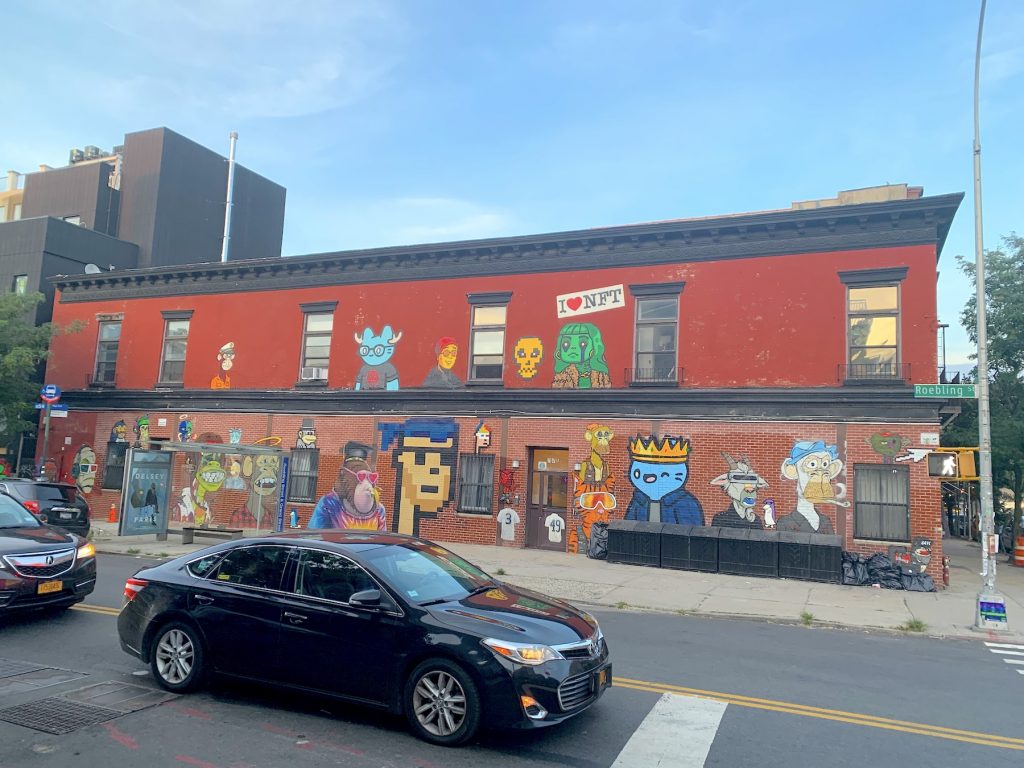
A hideous NFT themed mural by Another Flex on the Wall in Williamsburg, Brooklyn. Photo by Ben Davis.
People who promote the alternative NFT art world tend to speak very confidently about the evils of the traditional art world, which is perceived as hoarding economic opportunities that the magic of blockchain technology promises to open to all. But often it seems to me that this vision still doesn’t buy the traditional art world’s own hype.
The truth is that anyone who seriously studies the art market will know that traditional art is mainly a bad investment. Almost all new art is worthless; even most art that has its moment will not be worth a few years later. Only in truly exceptional cases does art appreciate radically over time, and these increases are almost impossible to predict.
The main reason to collect art is because… you actually like art, or want to support artists. To be fair, I heard NFT experts now say similar things at the recent NFT.NYC conference, in the face of price collapse. (Six months earlier, at the previous NFT.NYC, the line was “who will retire in three years?”)
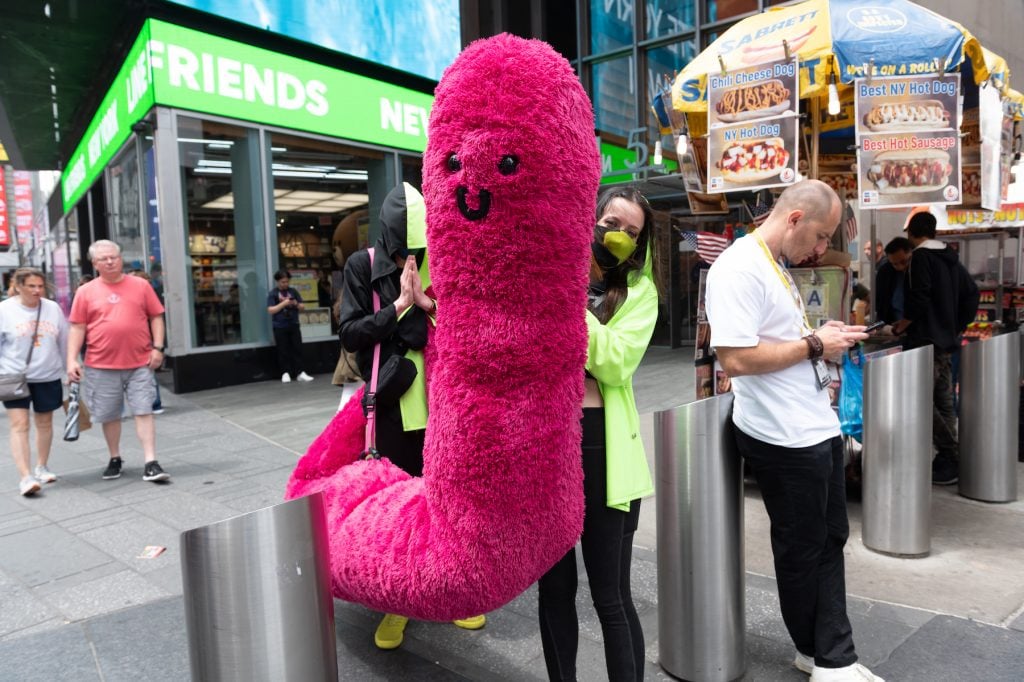
People walk with The Worm NFT character in Times Square during the fourth annual NFT.NYC convention on June 23, 2022 in New York City. .Photo by Noam Galai/Getty Images.
But it is still worth emphasizing: “democratizing” the financial possibilities of the art market means mainly democratizing the possibility of losing money on hyperspeculative assets. As Bloomberg reported last year, “A very small group of highly sophisticated investors are raking in most of the profits from NFT fundraising” – just like in the traditional art market.
And yet… just because most of the claims of money to be made from NFTs for the average person turn out to be smoke and mirrors does not mean that NFTs will disappear; there is too much money to be made in keeping the dream alive. Multi-level marketing outfits like Mary Kay and Herbalife also recruit people with grand promises of financial independence that turn out to be largely illusory. These operations have been criticized and sued and investigated as pyramid schemes – but new people sign up to become evangelists for their products every year.
Such schemes tend to flourish among segments of the population that feel cut off from economic opportunity: Mary Kay among housewives; Herbalife among immigrants; and crypto and NFTs among young men who see stagnant real economic opportunities.
The highly engaged audience of digital art day traders is truly something new, culturally, catering to a mass audience of self-identified “degenerates” (from “degenerate gambler”) that has no parallel in the traditional art market. Most NFT projects are definitely bubbles, but the NFT art and collectibles trading ecosystem is something more like a new form of art-themed online gambling. It scratches the same itch as horse racing or sports betting, but for digital natives.

Zed Run, the NFT-based horse racing game, sponsors the Wakeful Stakes at Flemington Racecourse in Flemington, Australia. Photos: winning IRL horse Willowy. (Reg Ryan/Racing Photos)
And gambling actually tends to thrive in economically uncertain times. In fact, the new field of “crypto addiction” is being treated as a subset of gambling addiction.
There is nevertheless a slightly less cynical reason to believe that the trade in NFTs will persist, on the artist side rather than the collector side. The innovation reflects a way of sustaining digital creativity, one that has proven potentially viable over the past year, beneath the foam. Society is increasingly centered on digital creativity.
Again, though, I think some of what this means is obscured by the usual breathless NFT sales talk. The proponents of web3 sound for all the world as if they are making the pitch Silicon Valley for a “new internet”, without any satire. You hear a lot about how NFTs will finally free the culture from the cruel grip of Web 2.0—that is, from the influence of the big platforms that have been snaring most of the profits from your attention economy, alphabets, and metas.
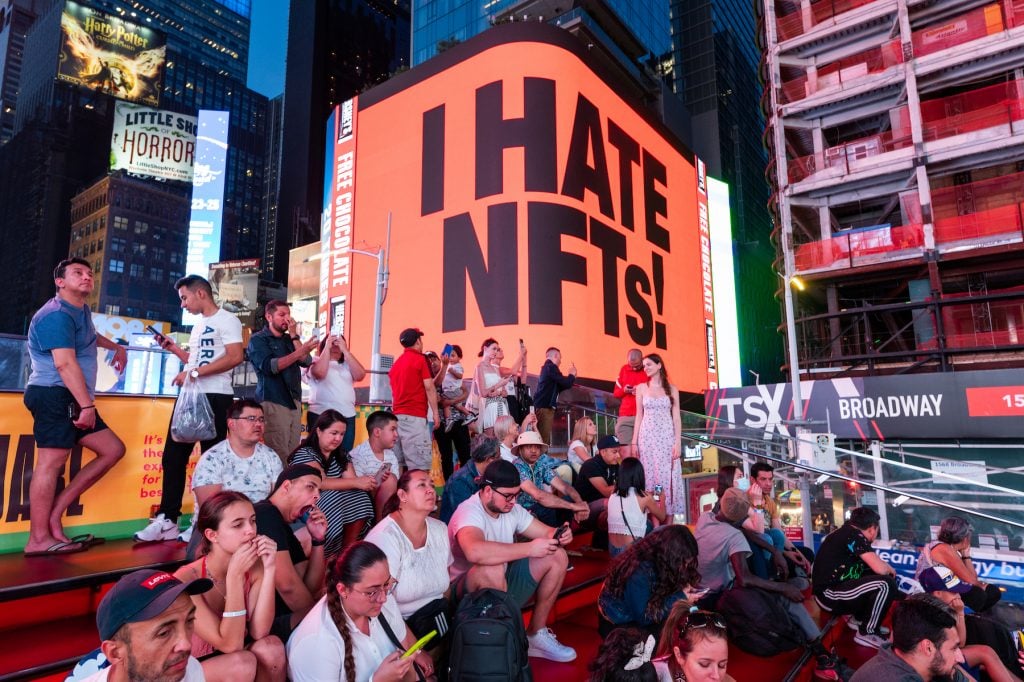
A billboard that reads: “I hate NFTs!” is seen behind people sitting on the red steps in Times Square during the 4th Annual NFT.NYC Conference on June 20, 2022 in New York City. (Photo by Noam Galai/Getty Images)
But as far as I can tell, success in the NFT space is very heavily based on the same viral dynamics and reliance on trending topics that have eroded media in the Web 2.0 era. After a year and a half of watching the NFT art world evolve, what has become clear is that even when a project catches fire, its mid-term value tends to follow the usual curve of viral fame and memes in general: There is an initial intense conversation as everyone tries to jump on a trend, which quickly gets old and quickly becomes yesterday’s lunch.
Critics roll their eyes and talk about the absurdity of “buying jpgs”. But even this way of criticizing NFTs inadvertently introduces an unhelpful analogy. Collectors are not buy a digital image (or rather a symbol pointing to a digital image) that functions as a discrete painting, as a “digital object.” The most engaged NFT audience is looking for a historya hype cycle whose fluctuations they can bet on.
It seems to me that this is where a lot of more traditional artists entering the NFT space go wrong, thinking they just want to “make an NFT” that will then be sold to an audience that will passively hold it. It doesn’t work like that; the people who want to put money into these things are looking for a constant narrative to keep the price up. Continuous commitment is necessary.
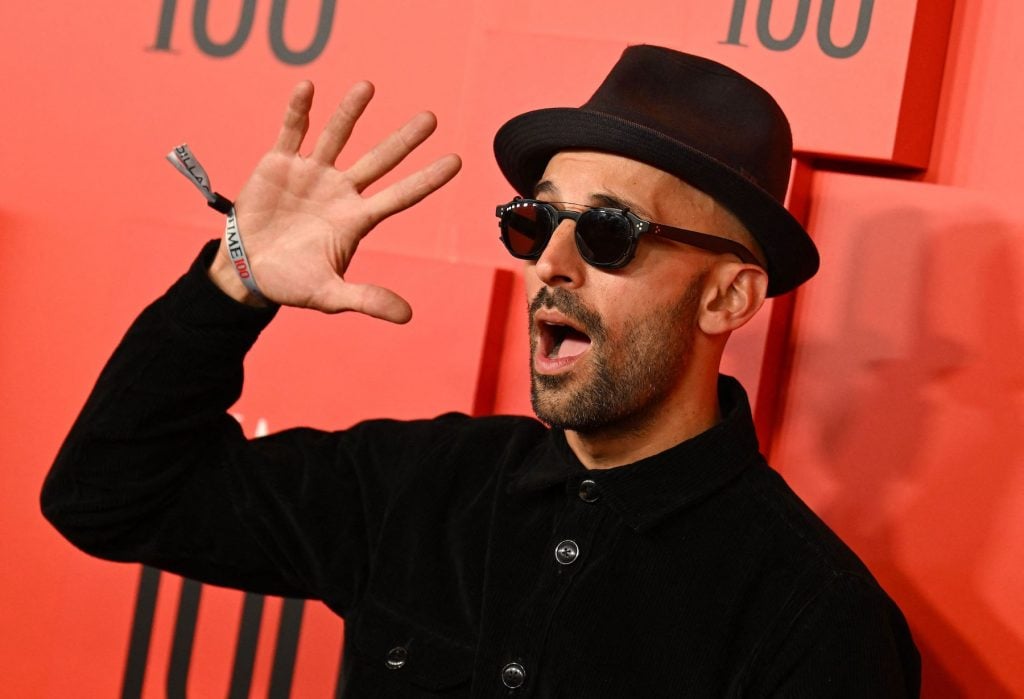
French photographer and street artist JR arrives at the Time100 Gala at Lincoln Center in New York, June 8, 2022. Photo by Angela Weiss/AFP via Getty Images.
The artist JR entered the NFTs last year to great enthusiasm. As can be seen on Discord, his collectors have been apoplectic that he has not abandoned his other art to shill his NFTs more, to pump the project. One angry former fan recently even created a mock animated version of his famous sunglasses-wearing face, in which JR is made to reassure his NFT holders in a shrill cartoon voice: “Hey guys, I haven’t forgotten about you! I think about you all the time I’m flying around the world and spending all your money!” Brutal.
JR is one of the most well-known, well-connected and media-savvy street artists in the world. If he can’t just sit back and let the NFTs circulate on their own, neither can any other artist who wants something like an ongoing practice in the space.
The tendency for the NFT conversation to be dominated by large collections of slightly varied images comes from the need to have a story. A larger number of associated images means more transactions which in turn means more potential news events and data points to watch, which in turn means more of a narrative to bet on.
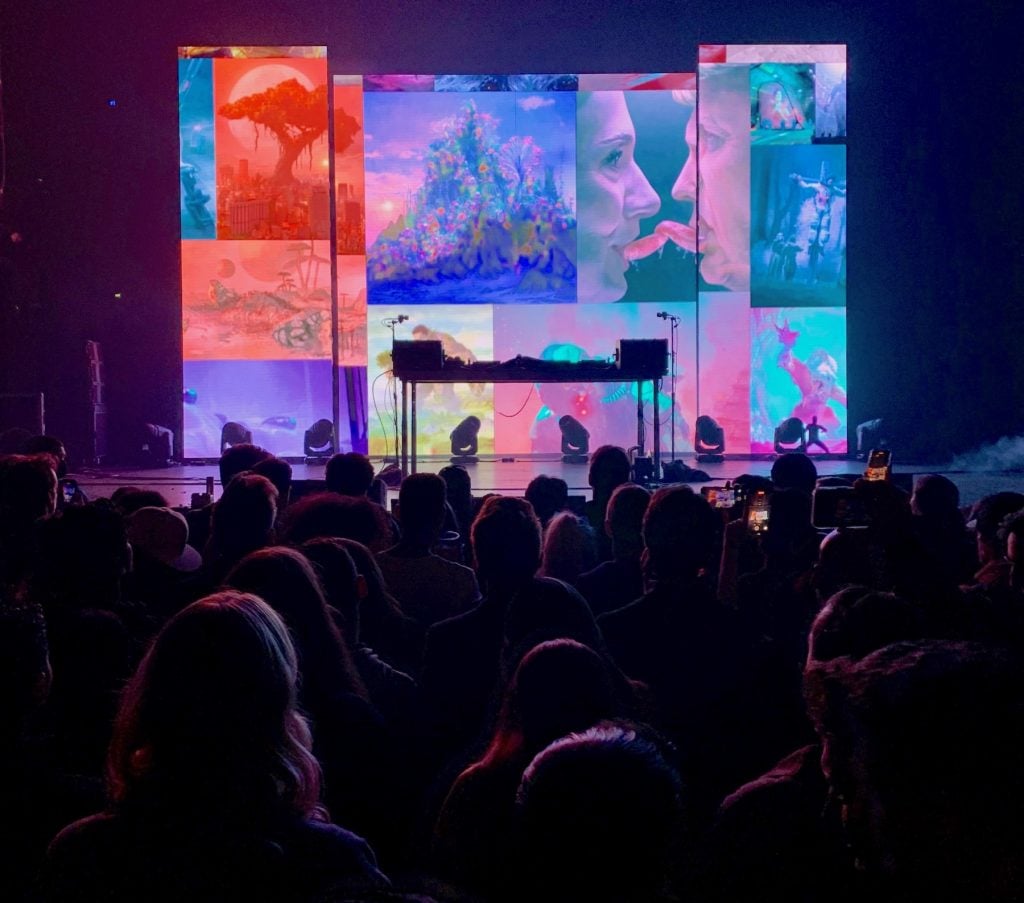
A movie by Beeple Weekdays – The first 5,000 days appears on Dreamverse. Photo by Ben Davis.
When it comes to “one-of-a-kind” art—the NFT way of saying “unique” artistic images rather than piles of digital collectibles like Apes or Punks—it seems significant that the most famous artist in the room, Beeple, had his fame grows out of his “Everydays” project of posting a new piece of art… every day.
Constant attention, constant new stories, is what is required to keep the ball of interest in the air, to guarantee a continuous drip-drip of interest. And so the effect of the NFTization of art is an expansion and intensification of the demands of the creative life in the age of social media and the tyranny of feeding the algorithm, not a more healthy, up with people alternative to it.
Sara Ludy, a successful digital artist based in New Mexico, recently spoke with my colleague Tim Schneider for the Art Angle podcast about the future of digital art. She spoke enthusiastically about the huge breakthrough NFTs represented for digital artists, being able to raise money for previously unworthy work, as well as for artists like herself, based outside of geographic art capitals. These are genuine items.
But this passage also stood out to me, and I think any artist looking at NFTs should think about it:
I don’t think the NFT space is a healthy space because of what is required of artists to constantly have to market and promote themselves. You have to be connected to Discord 24/7 and you’re basically juggling several other aspects of what it means to be an artist, and it’s exhausting. Personally, I’m actually in a digital detox and reassessing what it means to have a healthy, sustainable digital practice. It created from burnout. I can barely open my computer screen right now and actually struggled with the last few pieces in my show because I was burnt out from having to be online all the time.
NFTs may not look like the future right now. They look much more like the recent past weighing on the present. I don’t know if I would bet on their ability to escape it.
Follow Artnet News on Facebook:
Do you want to be at the forefront of the art world? Subscribe to our newsletter to get the latest news, eye-opening interviews and sharp critiques that drive the conversation forward.





















